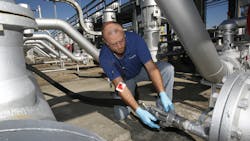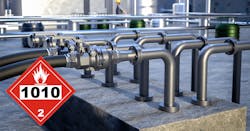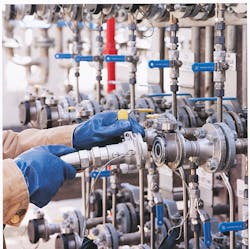Advanced couplers can help optimize the handling of hazardous chemicals
Without butadiene, people wouldn’t be able to drive their cars, cover their floors with carpet or go scuba diving. In other words, butadiene is one of those substances that most people probably have never heard of, but without it, we would not have the synthetic rubbers and elastomers that are integral components in the manufacture of vehicle tires, shag carpeting, and wetsuits, to name just a few of the many consumer goods that list butadiene as one of their indispensable ingredients.
At the same time, butadiene also is a chemical that producers and transporters know must be handled with care at all times.
Butadiene is a colorless, non-corrosive gas with a mild, gasoline-like aromatic odor that is a by-product of the production of ethylene and propylene. As such, it is listed as a potential occupational carcinogen by the National Institute for Occupational Safety and Health (NIOSH), and both short- and long-term exposure to it can cause a host of health issues. It is also extremely flammable in both its liquid and vapor forms, requiring butadiene transporters to take the highest precautions when handling it.
Butadiene is just one of many chemicals that come with a similar list of caveats from NIOSH that demand that they be produced, transported, and stored in the safest manner possible, with no risk of physical exposure to technicians or release to the environment. In this article, we will illustrate how using advanced dry-disconnect coupler technology can help reduce, or even eliminate, the risk that a chemical-release incident might occur during or at the conclusion of the loading and unloading of transport vehicles—most often railcars and tank trucks—into a storage vessel.
The chemical transport challenge
As noted, the main challenge in transporting chemicals is keeping them adequately contained. This is especially true if the chemical is transported as a liquefied compressed gas in a pressurized railcar. If any of these substances exceed their so-called boiling point during transport and begin to revert to a gaseous state, they will expand, thereby putting the ability of the transport vehicle to contain the chemical at risk. This could lead to a product release and, in the worst-case scenario, an explosion, depending on the chemical’s characteristics.
The overriding challenge, then, for the transporters of chemical substances is to prevent them from escaping the transport vehicle, whether in liquid or gaseous form, and reverting to a gaseous state, if applicable, during transport.
This challenge is made more difficult by the fact that many chemical transporters continue to rely on outdated coupler technology and “open-loop” systems to connect transfer hoses from the transport vehicle to the storage vessel. In many cases, this technology comes in the form of nothing more than a technician inserting a “stabber” pipe at the transfer point with a pipe wrench. These connections have some operational shortcomings that prohibit them from being the absolute best dry-disconnect choice. Mainly, open-loop systems do not possess the ability to ensure that a leak-free connection has been made, or to prevent residual product from remaining in the coupling connection when the hose is removed.
A better alternative to an open-loop system is the “closed-loop” system. In the closed-loop system, there is less risk that any product will remain in the coupler as it is disconnected, which lowers the exposure risk to almost zero, resulting in a safer chemical-transfer process.
Experience from the field tells us that there are two main obstacles to getting chemical manufacturers and transporters to convert from an open to a closed system of product transfer. The first one involves mindset, or “this is the way we’ve always done it” thinking that can hamper efforts to convince people there is a better way. The second—and much harder to overcome—is physical: most of the railcars that are used to transport chemicals are owned and operated by third-party carriers, not the actual manufacturer. This means that the storage terminal must be able to adapt its operations to meet the needs of each individual railcar that arrives. Since the product-transfer connections “live” on the railcars, the challenge is to get their manufacturers and operators to buy into the benefits of closed-loop loading and unloading systems, thereby making advanced dry-disconnect equipment standard on their fleets.
The dry-disconnect solution
Aiding the cause in convincing chemical manufacturers and transporters to upgrade to a closed-loop system is a comprehensive portfolio of advanced dry-disconnect couplers that now are available to the chemical-transport market. The foundation of this product portfolio is innovative flat-face poppet and double-ball-valve designs. These methods of construction help reduce the risk that residual fluid will be trapped within the coupler, lowering the risk of spills and giving the liquid virtually no place to collect or hide, which eases cleaning. Typically, there will be less than 0.5 ml (0.02 ounces) of fluid left on the face seal of the coupler upon disconnection, an amount that is less than one-quarter the volume of a single teardrop.
Finally, the couplers are quick and easy to maintain because they have fewer parts, which can allow them to be repaired on-site with no need for time-consuming and costly returns to the manufacturer or the need to interpret complicated and confusing maintenance instructions.
Here’s a closer look at three specific advanced dry-disconnect technologies, along with the benefits that each can offer to chemical transporters, all of which can be modified to fit the unique needs of the end-user’s operation:
- Flat-face poppet dry disconnects: These couplers, which can be mounted in any orientation, are the most commonly used advanced coupler technology because they feature a rugged design, excellent flow characteristics, and heightened product control. The flat-face poppet ensures minimal product loss at disconnection, while the fully interlocked double-safety connection system prevents opening if the coupler is not mated properly. Some models allow closure from both the coupler and adaptor side, which significantly reduces the risk of retention and spillage of any residual product at disconnection, helping keep hazardous substances inline and out of the environment. The locking handle on some models also is designed to remain in a locked position, to prevent accidental opening or closing of the valve. Additionally, an automatic locking mechanism that is signified by an audible “click” provides added protection, with detachment accomplished with an easy tug on the lock release. These couplers can be constructed of stainless steel, aluminum, Alloy 20, or Hastelloy C, making them compatible with a wide range of chemical compositions. Many models have also been approved for use by the Association of American Railroads (AAR) and Canadian Registration Number (CRN) regulating authorities.
- Double-ball-valve dry disconnects: This design gives the coupler double-shutoff reliability, which allows them to deliver the lowest product-loss rates in the industry. Multiple integrated interlocks help eliminate unintentional disconnects and the resulting product releases that can threaten worker safety and damage the environment. The coupler’s unrestricted flow path creates no turbulence during product transfer for full-flow optimization. Optional keyed couplings isolate transfer lines to provide further defense against cross-contamination. They are typically constructed of 316 stainless steel or Hastelloy C.
- Quick-connect dry disconnects: These couplers have been designed to be user-friendly due to quick, easy connection capabilities while also delivering minimal product loss at disconnection. Quick-connect couplers have also been designed to be interchangeable with other dry-disconnect models and are manufactured in accordance with NATO STANAG 3756 standards. They are usually constructed of 316 stainless steel and feature an integral heavy-duty swivel that minimizes hose wear, along with fully integrated interlocks and locking mechanisms that increase safety. Optional keyed couplings minimize the risk of product cross-contamination occurring when the same transport vessels are used to ship different chemicals.
Conclusion
Hazardous chemicals are indispensable ingredients in any number of products that are ever-present in our daily lives. At the same time, these dangerous chemicals must be handled with extreme care, lest the user or environment become harmed as a result of a leak, spill, or catastrophic release. Integral components in the safe handling and transfer of industrial chemicals are the couplers that help facilitate the transfer-hose connection point between transport vehicles and storage vessels. In this case, the use of advanced dry-disconnect technologies can greatly reduce the risk that hazardous chemicals will leak, drip, or nest within the coupler during and at the conclusion of their transfer, resulting in a safer, more reliable handling process for some of the world’s most significant—and potentially dangerous—raw materials.
David Morrow is director of sales for OPW Engineered Systems. He can be reached at (800) 547-9393 or [email protected].
From the field
One of the largest United States-based manufacturers of butadiene has several production facilities in the industrial corridor adjacent to the Houston Ship Channel and along the Gulf of Mexico. For decades, the manufacturer has transported butadiene via railcar and takes great pride in having received numerous safety awards based on having zero non-accident butadiene releases through safe loading practices that have been honored by its rail partners.
However, when performing an annual review of the effectiveness of its butadiene-safety program, the manufacturer became concerned that some butadiene particulate was remaining in the nipples and couplers on the valve systems at its facility and those that it does business with. Though the equipment met handling standards established by numerous regulatory agencies, the manufacturer was not content to let it perform beneath its elevated excellence expectations.
For 40 years, the company’s technicians had been loading and unloading butadiene railcars with the use of common tools and a lot of sweat equity. A worker would open the lid of the railcar’s manway, remove a plug with a 36-in. pipe wrench, pick up a 30-in. steel nipple and thread it into that valve. Then the worker would drag the hammer-union fitting to the nipple, put it on, then use a hammer to beat the fitting into place.
By converting to flat-face dry-disconnect coupler technology, all the technician has to do now is open the manway lid, pull the loading arm over, set the coupler fitting over the connection point and open the valve. That reduces the time needed to begin loading or unloading the butadiene from 30 minutes to only seconds.
By incorporating flat-face dry disconnects into its butadiene-transfer system, the manufacturer has realized four major benefits:
- Reduced emissions: Flat-face couplers feature no threaded connections that can allow the escape of fugitive emissions while meeting all regulatory emission requirements.
- Time savings: The average time needed to connect the loading arm to the railcar valves was reduced from 35 to 40 minutes to 35 to 40 seconds.
- Ergonomic benefits: Cheater bars, pipe wrenches, and hammers are no longer needed to connect the valves. With the flat-face couplers, the technician simply turns a lever to complete the connection with no required heavy lifting or bending over for long periods of time.
- Increased railcar safety: The dry disconnects are tamper-resistant, which helps eliminate the possibility of sabotage, theft, and product contamination since only the manufactured mating piece allows access to the system.


